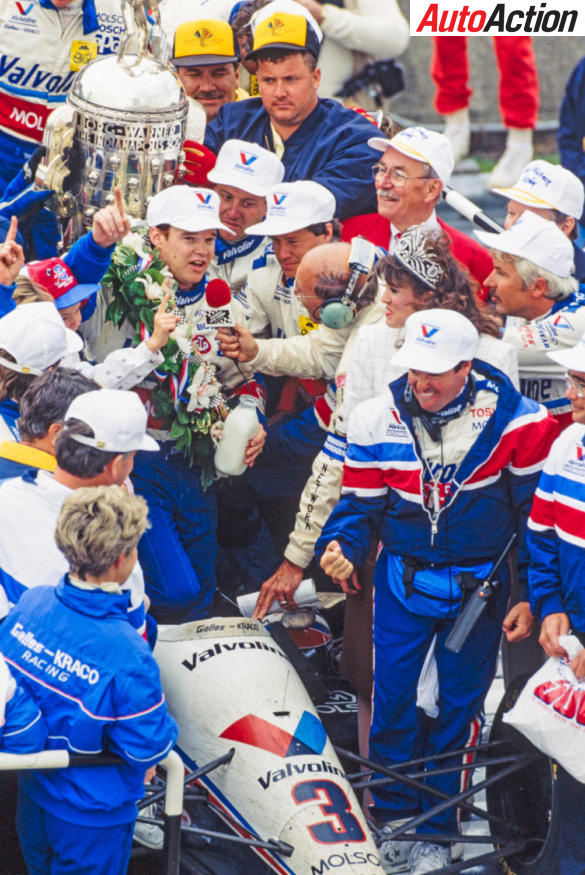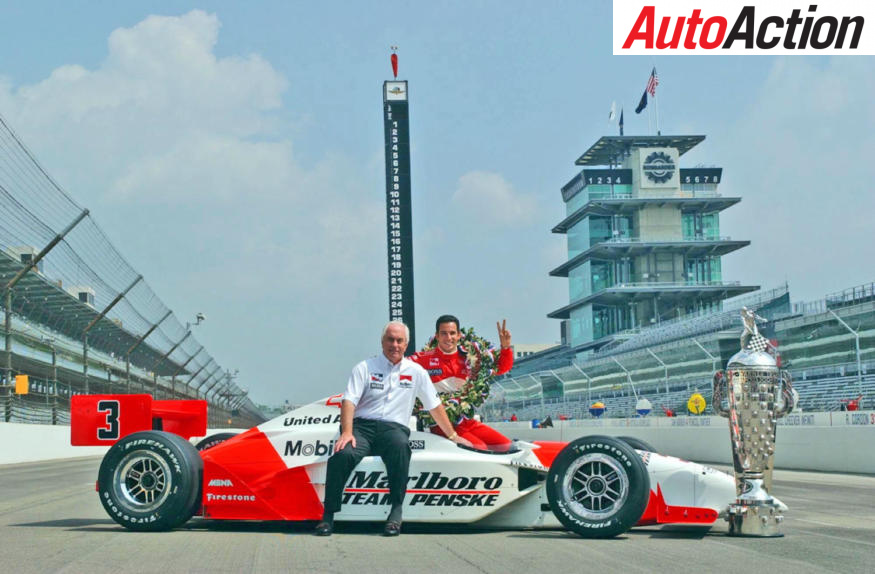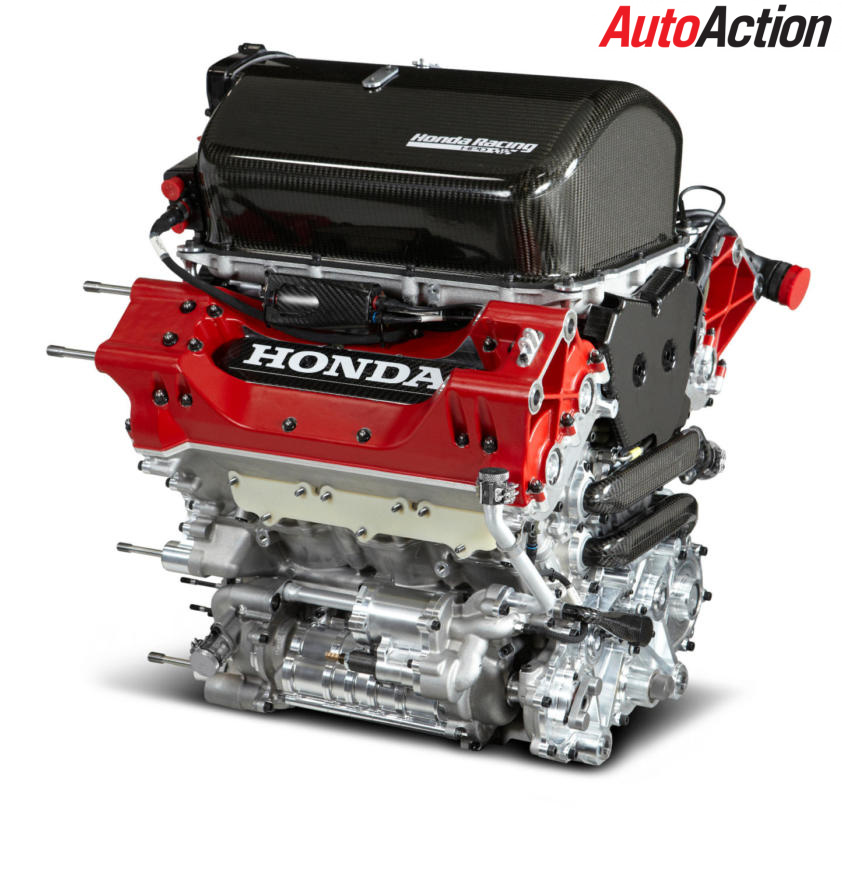INDIANAPOLIS 500 2022 PREVIEW ALMOST ANYONE’S RACE

Indy’s month of May thrills and spills is upon us again, and the 106th running of the 500 is an open race with many possible winners. DAN McCARTHY and MARK BISSET preview the race with some glances back at the past 60 years and their relevance today
Images: Motorsport Images/Indianapolis Speedway Museum
There is nothing like the roar of 275,000 race-fans at Indianapolis as the pace car takes the 33-car grid away at the start of their 200 lap, 500 mile, 2½ hour Memorial Day weekend journey. If the ‘Taps’ bugler doesn’t choke you up a bit, then The Star-Spangled Banner or Back Home in Indiana certainly will. Nobody does hoopla and razzamatazz quite like the Americans. The race truly is The Greatest Spectacle in Racing – add it to your ‘Bucket List’ if you’ve not been there.
The race has a rich history – both in technical terms and driver legend.

AJ Foyt en route to the last Indy win for a front-engined car, in 1964, aboard the Ansted-Thompson Racing, Watson Offenhauser.
One of the more significant contributions in the evolution of IndyCars was made by our very-own Jack Brabham. His revolutionary Cooper T54 Climax showed the potential of rear-engined cars to Indy’s front-engine Roadster Establishment in 1961.
But it was the speed of Jim Clark’s Lotus 29 Ford V8 in 1962 which rammed home the inevitability of rear-engined dominance. It took until 1965 for the Lotus/Ford/Clark combo to win at the 2.5-mile Brickyard, but 1962 – 60 years ago – heralded Indy’s modern era. Every contemporary 231mph-per-lap IndyCar is related to the 150mph-per-lap 1962 Lotus 29 in the same way every current Grand Prix car is related to the 1962 Lotus 25.

Colin Chapman, Jim Clark and the Lotus 38 Ford crew – including a very youthful Allan Moffat – at the 1965 Inadianapolis 500
Team Penske the team with the most Indy 500 wins
The quintessential American business and race-team is Team Penske. Roger Penske’s first big international win was bagged by Mark Donohue at Indy a half-century ago, in 1972. Donohue’s 700bhp McLaren M16B Offy triumphed over a strong field including works McLarens raced by American Aces Peter Revson and Gordon Johncock.
The combination of Penske’s money and management skill, and Donohue’s driving and engineering capabilities provided a Team Penske generation of success from the mid-60s until Donohue’s untimely August 1975 death, after a tyre failure-induced Austrian Grand Prix practice crash aboard a Penske March 751 Ford.

Mark Donohue and his Penske McLaren M16B Offy before winning the 1972 race. Superb packaging by Gordon Coppuck/John Barnard design is clear.
This year, Indy’s winningest team, with 18 Indy 500 wins, has all three of its drivers in title contention. Kiwi Scott McLaughlin took pole and the first race win of the year, Josef Newgarden won the second and third races, while Aussie Will Power is the only driver to finish in the top five of all races this season – and leads the championship as a result.
Last year’s Indy 500 was a disaster for the team. Power only just qualified, while McLaughlin was the highest of the (then) quartet, starting in 17th.
In the last 12 months Team Penske has done everything in its power to turn its oval form around. Since last year’s Indy, Newgarden has won both oval races and is confident after topping the last day of the open test.

Double champion Josef Newgarden is yet to win at Indy, but already has two wins under his belt this year.
Despite being a two-time champion, an Indy 500 win still eludes Newgarden.
“I can’t deny things feel really good on the #2 car,” Newgarden said.
“We’ve been on a good trajectory. I don’t want to see it flatten too much; I want to see it go the other way. I feel confident with what we’ve got, and feel good at showing up anywhere. Being at Team Penske makes that easier. I always feel confident in our group.”
McLaughlin has gone from rookie to championship contender in 12 months. He has shown he can win on the streets, doing so at St Petersburg and was one corner shy of winning at the Texas Motor Speedway more recently.
The former Supercars champion has taken to oval racing like a duck to water – and, aside from last year’s Indy 500 McLaughlin has finished comfortably inside the top 10 in all his oval races and was fifth fastest in the two-day test.

Scott McLaughlin ran the iconic Pennzoil livery last year – the young kiwi is now a race winner and championship contender
“Good few days across the bricks. Car feels solid; nice build up for May, can’t wait,” he said. “We are up there running with the big boys now. I learn every week.”
While Newgarden and McLaughlin are yet to drink the traditional winner’s milk, Power won in 2018 and his championship-leading consistency this year demonstrates he is in fine form and is confident of running strongly.
“I am really looking forward to this year’s Indy 500, really looking forward to the ‘Month of May.’ We have worked extremely hard in the off-season on development of the car and I think we are going to be right on the pace,” Power said in the lead-up.

Adrenalin-pumping pitstop for Will Power, Team Penske Chevrolet at Indy 500 in 2021
The Indy 500 history books are full of great motorsport tales:
A decade after Gordon Johncock’s 1972 McLaren M16B DNF, he won the 1982 Indy 500 for the second and final time aboard a Wildcat Mk8B Cosworth, designed by Gordon Kimball. Coincidently, Gordon is the father of IndyCar veteran Charlie Kimball who will not enter the 500 for the first time since 2010.

Slinky Wildcat! Gordon Johncock’s victorious Wildcat Mk8B Cosworth DFX in 1982. He beat Rick Mears’ Penske by one-tenth of a second.
It was a great result in a field dominated by factory-built March, Eagle and Penske machines, but the honour of the last ‘small’ manufacturer to win a 500 goes to the 1992 winning Galmer G92 Chev.
Thirty years ago, Al Unser Jr steered the Galles-Kraco Racing entry to victory in the closest even Indy finish – his margin over second-placed Scott Goodyear’s Lola T92/00 Chev was 0.043 seconds, not even the blink of an eye! The car was built by Galles Racing’s manufacturing subsidiary, Galmer Engineering, located in Bicester, Oxfordshire right in the heart of the UK’s Motor Sport (Thames) Valley.

Winners Are Grinners. Little Al Unser, the Galles crew and Galmer G92 Chev after victory in 1992.
Ten years later, the standardisation of chassis/engines had been the norm from 1997 when the chassis/engine options available to the teams were Dallara IR-7/G-Force GF01, and 4-litre, 32-valve Oldsmobile Aurora L47/Nissan Infiniti VH V8s.
Helio Castroneves took the second of his four wins that year (2002) aboard a Penske Dallara IR02 Chev. In 2001 he had become the first driver to win as a rookie, and again in his sophomore season, and was the early 2000s dominant Indy force.

Politically incorrect as it is, weren’t Marlboro’s colours wonderful! Roger Penske and Helio Castroneves with the winning 2002 Dallara Chev.
Last year he was a surprise victor. At 46 years of age, he had a one-off drive with the burgeoning Meyer Shank Racing squad … that win led to a full-time drive this year.
A team on the rise, Meyer Shank made its Indy debut in 2017. its first full-time IndyCar campaign was in 2020, and this year is running two cars – former Indy 500 winner Simon Pagenaud is a massive asset to the team.
This year, Castroneves seeks to become the first five-time 500 race winner. Currently level on four wins with AJ Foyt, Rick Mears and Al Unser, his Indy offensive didn’t start well. He crashed exiting pit lane on the first day of testing, sustaining heavy damage to his Dallara, and was forced to sit out the following day’s running too.

Helio Castroneves and Palou in close company during 2021’s race.
At Indy, the recent form has been with Honda who have powered the last two 500 victors. However, it is clear that Chevrolet has made progress with its engine during this last off-season – the first four 2022 races went Chev’s way (and last weekend’s rain-fest at Indy’s road course wasn’t about engine power!), so the engine contest at Indy looks like being intriguing.
“I continue to be impressed with the rebound by Chevrolet this season,” said long-time IndyCar writer Paul Kelly.
“Let’s not sugar-coat it: Honda was superior in the last two seasons, winning the championship and Indianapolis 500 both years. Honda won 10 races to Chevy’s six in 2021, but Chevy has re-emerged as a Race Day force in 2022.
“It will be interesting to see how Chevy’s resurgence looks at Indy, where it powered only two of the first nine starters in the 500 last year and only one of the first 12 starters in 2020.

2012 Honda Indy V6 engine that will compete in the 2012 IndyCar racing series. Courtesy of Honda ©2012 LAT Photo USA
“The power pendulum appears to have swung back toward Detroit in the last 12 months, and I would be stunned if Honda – still a formidable and reliable rival for Chevy – locks down the front of the starting grid in a similar fashion this year.”

Panoramic 2012 Safety Car finish. Dario Franchitti and Scott Dixon’s Ganassi Dallara DW12 Hondas in front of Tony Kanaan’s DW12 Chev.
Chip Ganassi Racing has had a fantastic decade. Since 2012 it has won five IndyCar Series – Scott Dixon 2013, 2015, 2018, 2020 and Alex Palou in 2021 – but at Indy things have been a bit lean since Dario Franchitti’s victory a decade ago.
That was the year the current 2.2-litre V6 twin-turbo engine package debuted. This year, the team’s Dallara IR18 Hondas are being driven by Alex Palou, Scott Dixon, Marcus Ericsson, Jimmie Johnson and Tony Kanaan.
While it may be a lengthy winless drought, it’s not through lack of speed. Last year Dixon took his fourth pole.
With six IndyCar titles Dixon is desperate to add to his sole 2008 Indy win. Since then he has started on pole three times, but things just haven’t gone his way. Towards the end of his career, the 41-year-old still has the drive, motivation and pace to win another Indy 500. He was quickest on the first open test day showing he will again be a contender.

Start, Scott Dixon, Chip Ganassi Racing Honda led the field aways at the start of the 2021 Indianapolis 500
Despite being the reigning series winner, Palou is still after his first oval win. What a place Indy would be to do it! Palou finished second last year after leading as late as lap 198 before being overhauled … so it’s not through lack of oval racing prowess.
Castroneves believes that his experience over Palou proved crucial to his victory but doesn’t feel he could overhaul him again.
“Clearly, he’s getting more experience all the time. I’m glad I got him when I did,” he said.
This year the young Spaniard is feeling a lot more confident.
“We were really good at the Speedway test,” Palou said after finishing seventh on the overall speed chart. “Really good, really comfortable – a lot better than we did at the same test last year.”
His team-mate, former F1 driver Marcus Ericsson, also lacks oval racing experience, but he believes he made large gains at Texas earlier in the year.
“I’m very confident,” he said. “I’ve been working a lot on trying to improve my oval strength and Texas was a good result for me and my confidence; and that’s something I’m bringing into the month of May.
“We have an extremely strong organisation right now, especially with Tony (Kanaan) joining the team. It’s a privilege to be team-mates with all these great drivers.”

Scott Dixon and Alex Palou, and their boss Chip Ganassi during Front Row photo session at Indianapolis Motor Speedway on Monday May 23.
Yes, once again, former 500 winner Kanaan joins the team for the 500 and will doubtless prove a useful asset and 500 victory dark horse. Another is Jimmie Johnson – the NASCAR star shone on his oval debut earlier in the year.
The Indy 500 is steeped in tradition and as American as Apple Pie but it’s a truly international race. 1995 was the first year that more than 50% of competitors hailed from countries other than the US.
In the last decade and a half there have been only two American Indy 500 winners – Ryan Hunter-Reay and, most recently in 2016, Alexander Rossi. Both won with Andretti Autosport, a team that hasn’t won since.
Rossi’s 2016 victory was something special. As a rookie he outsmarted the opposition to win the 100th edition of the race. The last two seasons and 500s haven’t gone to plan, so while not a favourite, rule him out at your peril.
On his day Andretti’s Colton Herta is unstoppable – his win in appalling conditions last weekend was epic. The youngster is fast but prone to mistakes – his day at the 500 could go either way!
Their Andretti Indy 500 rookie teammate is 10-time F1 podium finisher Romain Grosjean. The Frenchman has shown great pace in his only two oval races to date, but failed to finish strongly. Utterly fearless he will be as much of a contender as Herta.

Pato O’Ward – Arrow McLaren SP Chevrolet talks with #48: Jimmie Johnson – Chip Ganassi Racing Honda
Last year there were only two rookies – this year there are seven, from diverse backgrounds and experience.
While Grosjean is the headliner, a couple of Formula 2 Championship front-runners will debut – Christian Lundgaard and 2020 series runner-up Callum Ilott, who is being coached by Hunter-Reay.
The three youngsters who have risen through American feeder series, David Malukas, Devlin De Francesco and Kyle Kirkwood, all thus have oval experience,. while lots of eyes will be on our final rookie, seven-time NASCAR champion Johnson.

Pato O’Ward, Arrow McLaren SP Chevrolet will be won of the hot contenders
Arrow McLaren SP is in hot form after a lacklustre start to the season. Pato O’Ward took victory in Alabama. When he is happy, the team and car perform strongly. He was third on the 500’s final lap last year and finished fourth. Like Palou, he has more experience this time around.
Despite showing great qualifying pace this year, his team-mate, Felix Rosenqvist, has had wretched luck in races – but it’s only a matter of time before he breaks through with McLaren and again proves his mettle.
Former race winner Juan Pablo Montoya is aboard the third McLaren and will be looking to improve on his ninth-place finish last year.
Other entrants include runner-up finishers Marco Andretti and JR.Hildebrand.
Two-time winner Takuma Sato always lifts his game during the Indy 500 week as does veteran Graham Rahal.

Former Indy 500 Champion Takuma Sato is always in the mix, driving for Dale Coyne Racing with RWR Honda
Other notables to keep an eye on include the Ed Carpenter Racing trio of Carpenter, Conor Daly and Rinus VeeKay.
With exactly 33 cars entering this year, qualifying has been altered by adding an additional session.
The top 12 drivers go into a shootout, before the fastest six progress to a second, final qualifying shootout. The winner of that will start the 500 from pole.
Last year the Indy 500 speed record was broken – Castroneves won in 2h 37m with an average of 306.885kp/h. Quite what the victor of the inaugural 1911 Indy 500, Ray Harroun would have made of this would be fascinating.
He, and Cyrus Patsche, who relieved him for 35 laps, took 6h 42m for a race average of 120.060kp/h aboard their Marmon Model 32 based Wasp, so named for its wasp-like tail.
Of all the major motor races in the world, the Indianapolis 500 has the widest range of potential winners – and potential surprise endings. The track is unique and thus even current championship form can go out the window.

#3: Scott McLaughlin, Team Penske Chevrolet at Indianapolis Motor Speedway on Saturday May 21, 2022.
The Auto Action office picks for the top five are Newgarden, McLaughlin, Palou, O’Ward and Scott Dixon. But absolutely anything can happen at Indy … Gentlemen, start your engines!






